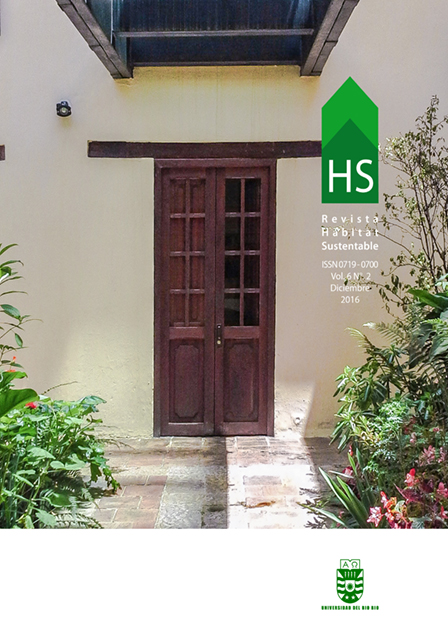Materiales de aislamiento térmico de edificios. Además de la energía operativa.
Palabras clave:
evaluación del ciclo de vida,, evaluación de la sostenibilidad, energía operativa, materiales de aislamiento, la paradoja del aislamientoResumen
La utilización de materiales de aislamiento térmico para la obtención de edificios energéticamente y conscientes tiene como objetivo, en general, la satisfacción de las necesidades de calefacción y refrigeración de la fase operativa. El objetivo principal de este trabajo es el de - mediante la utilización de metodología exploratoria, en particular la revisión bibliográfica de materiales de aislamiento más sostenibles y, concomitante, exponer el efecto paradójico de otros con un elevado potencial de calentamiento global (GWP) el papel de la Evaluación de Ciclo de Vida (ACV), del Ecodesign y de la Declaración Ambiental de Producto (DAP) para la concepción, comparación y selección de materiales. Como principal conclusión, se destaca la ausencia generalizada de información medioambiental por parte de los productores, que, al margen de los precios de adquisición que no internalizan los Costos de Ciclo de Vida (LCC), ha conducido a la utilización de materiales con elevada huella de carbono y a la "paradoja del aislamiento"
Descargas
Citas
ASCENSO, Rita. Pensar Sustentável! Edifícios e Energia, 2013, no 85, pp. 8-15.
BRAGANÇA, Luís e MATEUS, Ricardo. Avaliação do ciclo de vida dos edifícios – impacte ambiental de soluções construtivas. Guimarães: Ed. Autor, 2011.
BRAGANÇA, Luís; MATEUS, Ricardo e KOUKKARI, Heli. Building Sustainability Assessment. Sustainability, 2010, no 2, pp. 2010-2023.
BUYLE, Mattias, BRAET, Johan e AUDENAERT, Amaryllis. Life cycle assessment in the construction sector: A review. Renewable and Sustainable Energy Reviews, 2013, no 26, pp. 379-388.
CILECCTA. Sustainability within the Construction Sector: CILECCTA - Life Cycle Costing and Assessment. Oslo: SINTEF Building and Infrastructure, 2013.
CRAWFORD, Robert. Life Cycle Assessment in the Built Environment. Oxon: Spon Press, 2011.
ECOVATIVE. Ecovativedesign. Building Insulation [em linha]. [Consultado 10 setembro 2014]. Disponível na: http://www. ecovativedesign.com/products-and-applications/insulation
JESWIET, Jack e HAUSCHILD, Michael. EcoDesign and future environmental impacts. Materials and Design, 2005, no 26, pp. 629-634.
LABORATÓRIO NACIONAL DE ENGENHARIA CIVIL - LNEC. Regras para a concessão de uma Aprovação Técnica Europeia (ETA) ou de um Documento de Homologação (DH) a Sistemas Compósitos de Isolamento pelo Exterior (ETICS). Lisboa: Departamento de Edifícios - Núcleo de Revestimentos e Isolamentos, 2010.
MINISTÉRIO DO AMBIENTE, DO ORDENAMENTO DO TERRITÓRIO E DO DESENVOLVIMENTO REGIONAL - MAOTDR. Regulamento dos Requisitos Acústicos dos Edifícios. 2008. Decreto-lei no96/2008 de 9 de Junho. Lisboa: Diário da República, 1a Série, 2008.
OLIVEIRA AUGUSTO, Carlos. A metodologia de Avaliação do Ciclo de Vida na definição de critérios de sustentabilidade em edifícios. Lisboa: Universidade Lusíada Editora, 2011.
PFUNDSTEIN, Margit; GELLERT, Roland; SPITZNER, Martin H. e RUDOLPHI, Alexander. Insulating Materials. Munich: Detail Practice, 2008.
UNITED NATIONS ENVIRONMENT PROGRAMME – UNEP. Ozone Secretariat. Handbook for the Montreal Protocol on Substances that Deplete the Ozone Layer. 9a ed. Nairobi: UNON, 2012.
UNITED STATES ENVIRONMENTAL PROTECTION AGENCY - EPA. Transitioning to low-GWP alternatives in building / construction foams [em linha]. [Consultado 9 setembro 2014]. Disponível na: http://www.epa.gov/ozone/downloads/EPA_ HFC_ConstFoam.pdf
WILSON, Alex. Avoiding the Global Warming Impact of Insulation. Environmental Building News, 2010, vol. 19, no 6, pp. 58-67.
Descargas
Publicado
Cómo citar
Número
Sección
Licencia
El contenido de los artículos que se publican en cada número de Hábitat Sustentable, es responsabilidad exclusiva de los autores y no representan necesariamente el pensamiento ni comprometen la opinión de la Universidad del Bío-Bío.
Los autores/as conservarán sus derechos de autor y garantizarán a la revista el derecho de primera publicación de su obra, el cuál estará simultáneamente sujeto a la Licencia de Reconocimiento de Creative Commons CC BY-SA que permite a otros compartir-copiar, transformar o crear nuevo material a partir de esta obra con fines no comerciales, siempre y cuando se reconozcan la autoría y la primera publicación en esta revista, y sus nuevas creaciones estén bajo una licencia con los mismos términos.











 Programa de Información Científica/Concurso Fondos de Publicación de Revistas Científicas 2018/ Proyecto Mejoramiento de Visibilidad de Revistas UBB (Código:FP180007)
Programa de Información Científica/Concurso Fondos de Publicación de Revistas Científicas 2018/ Proyecto Mejoramiento de Visibilidad de Revistas UBB (Código:FP180007) 





